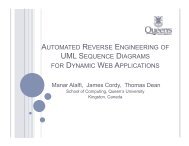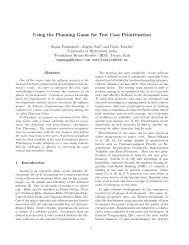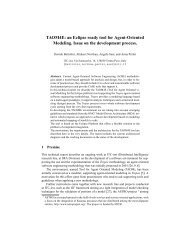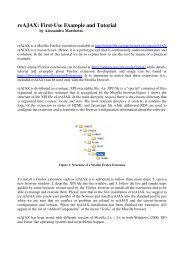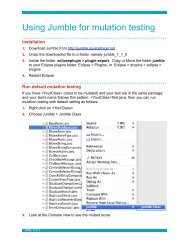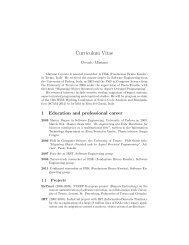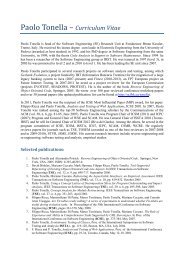PDF version of the paper. - FBK | SE
PDF version of the paper. - FBK | SE
PDF version of the paper. - FBK | SE
You also want an ePaper? Increase the reach of your titles
YUMPU automatically turns print PDFs into web optimized ePapers that Google loves.
Towards Experimental Evaluation <strong>of</strong> Code ObfuscationTechniquesMariano Ceccato 1 , Massimiliano Di Penta 4 , Jasvir Nagra 5 , Paolo Falcarin 3 ,Filippo Ricca 2 , Marco Torchiano 3 , Paolo Tonella 11Fondazione Bruno Kessler–IRST, Trento, Italy2Unità CINI at DISI, Genova, Italy3Politecnico di Torino, Italy4RCOST - Dept. <strong>of</strong> Engineering - University <strong>of</strong> Sannio, Benevento, Italy5University <strong>of</strong> Trento, Italyceccato|tonella@fbk.eu, dipenta@unisannio.it, jas@nagras.compaolo.falcarin|marco.torchiano@polito.it, filippo.ricca@disi.unige.itABSTRACTWhile many obfuscation schemes proposed, none <strong>of</strong> <strong>the</strong>m satisfyany strong definition <strong>of</strong> obfuscation. Fur<strong>the</strong>rmore secure generalpurposeobfuscation algorithms have been proven to be impossible.Never<strong>the</strong>less, obfuscation schemes which in practice slow downmalicious reverse-engineering by obstructing code comprehensionfor even short periods <strong>of</strong> time are considered a useful protectionagainst malicious reverse engineering. In previous works, <strong>the</strong> difficulty<strong>of</strong> reverse engineering has been mainly estimated by means <strong>of</strong>code metrics, by <strong>the</strong> computational complexity <strong>of</strong> static analysis orby comparing <strong>the</strong> output <strong>of</strong> de-obfuscating tools. In this <strong>paper</strong> wetake a different approach and assess <strong>the</strong> difficulty attackers have inunderstanding and modifying obfuscated code through controlledexperiments involving human subjects.Categories and Subject DescriptorsD.2.8 [Metrics]General TermsSecurity, Experimentation, MeasurementKeywordsEmpirical studies, S<strong>of</strong>tware Obfuscation1. INTRODUCTIONSource code obfuscation is widely used to prevent/limit maliciousattacks to s<strong>of</strong>tware systems conducted by decompiling andunderstanding or modifying source code. In particular client applicationsin distributed application represent a privileged target forthis kind <strong>of</strong> attacks. For instance many networked Java applicationsare <strong>of</strong>ten built as two components, a server run in a controlledenvironment and a client, <strong>of</strong>ten distributed as bytecode and run inPermission to make digital or hard copies <strong>of</strong> all or part <strong>of</strong> this work forpersonal or classroom use is granted without fee provided that copies arenot made or distributed for pr<strong>of</strong>it or commercial advantage and that copiesbear this notice and <strong>the</strong> full citation on <strong>the</strong> first page. To copy o<strong>the</strong>rwise, torepublish, to post on servers or to redistribute to lists, requires prior specificpermission and/or a fee.QoP’08, October 27, 2008, Alexandria, Virginia, USA.Copyright 2008 ACM 978-1-60558-321-1/08/10 ...$5.00.a virtual machine which can easily be decompiled, understood, andpatched to behave according to attacker intentions. Despite <strong>the</strong>proved <strong>the</strong>oretical impossibility <strong>of</strong> building general purpose obfuscators[2], implementations <strong>of</strong> obfuscators exist and are usedin practice. Available obfuscators provide limited though effectiveprotection against malicious reverse engineering by making codehard to understand and/or difficult to analyze through automaticcode analysis tools [9]. However, few works cope with <strong>the</strong> problem<strong>of</strong> measuring <strong>the</strong> extent <strong>of</strong> protection <strong>of</strong>fered by state <strong>of</strong> <strong>the</strong> artcode obfuscation techniques.The notion <strong>of</strong> reverse engineering complexity <strong>of</strong> obfuscated codeis captured by <strong>the</strong> intuitive notions <strong>of</strong> potency and resilience. Potencyis <strong>the</strong> amount <strong>of</strong> obscurity added to <strong>the</strong> code, i.e. how muchmore complex to understand and to analyze is <strong>the</strong> obfuscated codewith respect to <strong>the</strong> original one. Resilience measures, instead, howdifficult it is to automatically break <strong>the</strong> obfuscation.This <strong>paper</strong> details <strong>the</strong> definition, design and planning <strong>of</strong> a series<strong>of</strong> controlled experiments aimed at empirically assessing <strong>the</strong> capability<strong>of</strong> source code obfuscation techniques — namely identifierrenaming and opaque predicates — to reduce <strong>the</strong> capability <strong>of</strong> asubject to successfully complete an attack, and to increase <strong>the</strong> effortneeded for <strong>the</strong> attack. The study was performed asking subjectto perform understanding tasks or change tasks on <strong>the</strong> decompiled(ei<strong>the</strong>r obfuscated or clear) client code <strong>of</strong> client-server Java applications.We report preliminary results obtained in a first experimentperformed with 8 graduate students and related to <strong>the</strong> effectiveness<strong>of</strong> <strong>the</strong> identifier renaming obfuscation on Java code.In <strong>the</strong> past, evaluation <strong>of</strong> obfuscation has been mainly addressedthrough code metrics or by applying automatic de-obfuscators. In [15],<strong>the</strong> amount <strong>of</strong> time required to perform automatic de-obfuscationis used to evaluate <strong>the</strong> control-flow flattening obfuscation, relyingon a combination <strong>of</strong> static and dynamic analysis. An attempt toquantify and compare <strong>the</strong> level <strong>of</strong> protection <strong>of</strong> several obfuscationtechniques is presented by Anckaert et al. [1]. Their contributionis a series <strong>of</strong> metrics based on code, control flow, data and dataflow. They computed such metrics on some case study applications(both on clear and obfuscated code) but no attempt has been madein <strong>the</strong> direction <strong>of</strong> validating such metrics. Our contribution is, instead,devoted to assess obfuscation empirically. We compare <strong>the</strong>performance <strong>of</strong> human subjects while performing attack tasks bothon obfuscated and clear code.The work more similar to ours is a study on <strong>the</strong> complexity <strong>of</strong> reverseengineering binary code, that involved human subjects [13].A group <strong>of</strong> 10 students (<strong>of</strong> heterogeneous level <strong>of</strong> experience) has
een asked to perform static analysis, dynamic analysis and modificationtasks on several C compiled programs. While <strong>the</strong> studentsability to successfully achieve <strong>the</strong> reverse engineering tasks showeda correlation with <strong>the</strong> student experience, no correlation was observedbetween ability and source code complexity metrics (Halsteadand McCabe metrics). Our empirical evaluation has a differentaim. We intend to measure <strong>the</strong> effect size <strong>of</strong> obfuscation, i.e.,quantify <strong>the</strong> increased effort necessary to reverse engineer an obfuscatedprogram, compared to <strong>the</strong> effort necessary for a programin clear. Such effect size is <strong>the</strong> fundamental metrics that may justify<strong>the</strong> adoption <strong>of</strong> available obfuscators. Moreover, it allows tocompare alternative obfuscators in terms <strong>of</strong> increased tamper resistance.The <strong>paper</strong> is organized as follows: Section 2 provides a primeron <strong>the</strong> obfuscation techniques we considered. Section 3 gives <strong>the</strong>details <strong>of</strong> <strong>the</strong> experimental design we used and Section 4 reportspreliminary experimental results and threats to validity. Section 5concludes <strong>the</strong> <strong>paper</strong>.2. A PRIMER ON OBFUSCATIONTECHNIQUESThis section briefly describes <strong>the</strong> code obfuscation techniquesused in our experiments.Obfuscation transformations are classified into three classes [4]:layout obfuscations, removing relevant information (such as identifiernames) from <strong>the</strong> code without changing its behavior; data obfuscations,transforming application data and data structures (e.g.,data encoding, data splitting); and, control-flow obfuscations, altering<strong>the</strong> original flow <strong>of</strong> <strong>the</strong> application. The most relevant techniquesfor <strong>the</strong> present work are identifier renaming and opaquepredicates.Identifier renaming is an instance <strong>of</strong> layout obfuscation that removesrelevant information from <strong>the</strong> code by changing <strong>the</strong> names<strong>of</strong> classes, fields and operations into meaningless identifiers, so asto make it harder for an attacker to guess <strong>the</strong> functionalities implementedby different parts <strong>of</strong> <strong>the</strong> application. There are several features<strong>of</strong> identifier renaming which are worth noting. It is a widelyimplemented obfuscation technique, implemented by many commercialand academic obfuscators. The original identifiers are lostduring renaming and in this sense <strong>the</strong> obfuscation is irreversible.With intelligent and human assisted analysis, one may be able toprovide some meaningful identifiers, however, <strong>the</strong> original identifiersare lost. Identifier renaming also has no performance overheard.Never<strong>the</strong>less much <strong>of</strong> <strong>the</strong> structure <strong>of</strong> <strong>the</strong> program is preservedwhich may assist an attacker during reverse-engineering. An extension<strong>of</strong> this technique was proposed by Tyma [14] where instead<strong>of</strong> renaming an identifier to a new meaningless one, identifiers arereused whenever possible but in such a way that overloading resolves<strong>the</strong> introduced ambiguity correctly.Obfuscation based on Opaque predicates [5] is a control-flowobfuscation that tries to hide <strong>the</strong> original behavior <strong>of</strong> an applicationby complicating <strong>the</strong> control flow with artificial branches. Anopaque predicate is a conditional expression whose value is knownby <strong>the</strong> obfuscator, but is hard to deduce statically by an attacker. Anopaquely True (False) predicate always evaluates to True (False) ata given position in a program. An opaque predicated can be usedin <strong>the</strong> condition <strong>of</strong> a newly generated if statement. One branch <strong>of</strong><strong>the</strong> if statement is filled with <strong>the</strong> original application code, while<strong>the</strong> o<strong>the</strong>r is filled by a bogus <strong>version</strong> <strong>of</strong> it. Only <strong>the</strong> former branchwill be executed, causing <strong>the</strong> semantics <strong>of</strong> <strong>the</strong> application to remain<strong>the</strong> same. In order to generate resilient opaque predicates, pointerTable 1: Overview <strong>of</strong> <strong>the</strong> experiment.GoalTo analyze <strong>the</strong> effect <strong>of</strong> source code obfuscationtechniquesQuality focus Capability <strong>of</strong> understanding <strong>the</strong> obfuscatedcodeCapability to perform attacks on <strong>the</strong> obfuscatedcodeContextObjects: two Java client-server applications:Car Race and ChatSubjects: Graduate studentsNull hypo<strong>the</strong>ses H 01 : no effect <strong>of</strong> obfuscation on understandinglevelH 02 : no effect <strong>of</strong> obfuscation on <strong>the</strong> capability<strong>of</strong> performing a change taskH 03 : no effect on <strong>the</strong> time needed forcomprehensionH 04 : no effect on <strong>the</strong> time needed forcompleting a change taskMain factorObfuscationTreatments Decompiled, obfuscated code vs. decompiled,clear codeO<strong>the</strong>r factors Subjects’ Ability, System, LabDependent variables (i) Ability to perform comprehensiontasks(ii) Time required for comprehension(iii) Ability to correctly perform achange task(iv) Time required to perform a changetaskaliasing can be used, since inter-procedural static alias analysis isknown to be intractable.3. EXPERIMENT PLANNINGThis section describes <strong>the</strong> definition, design and settings <strong>of</strong> <strong>the</strong>proposed experimentation following <strong>the</strong> Goal Question Metric template[3] and guidelines by Wohlin et al. [16] and [11]. The studydefinition is summarized in Table 1.The goal <strong>of</strong> this empirical study is to analyze <strong>the</strong> effect <strong>of</strong> sourcecode obfuscation techniques with <strong>the</strong> purpose <strong>of</strong> evaluating <strong>the</strong>ireffectiveness in making <strong>the</strong> code resilient to malicious attacks. Thequality focus regards how <strong>the</strong> obfuscation reduces <strong>the</strong> attacker capabilityto understand and modify <strong>the</strong> source code, and above allhow <strong>the</strong> obfuscation increases <strong>the</strong> effort needed to successfullycomplete an attack. This is a crucial point in our experimentation:although we are aware that an attacker could be able to completean attack on obfuscated code anyway, she/he could be discouragedif such an attack requires a substantial effort/time. Results <strong>of</strong> thisstudy can be interpreted from multiple perspectives:1. a researcher would be interested to assess an obfuscationtechnique. Most existing assessments (e.g., [1, 8]) are basedon metrics, estimating <strong>the</strong> increased code complexity, or onarguments about <strong>the</strong> increased difficulty <strong>of</strong> static code analysis(e.g., computational complexity <strong>of</strong> static alias resolutioninvolved in a successful attack). Only a few works are basedon attacks performed by human subjects [13] and none, to<strong>the</strong> authors’ knowledge, applied rigorous approaches, suchas those available from <strong>the</strong> area <strong>of</strong> empirical s<strong>of</strong>tware engineering[11].2. a practitioner, who wants to ensure high resilience to attacksto <strong>the</strong> part <strong>of</strong> a distributed application delivered to <strong>the</strong> clients,running in an untrusted environment.
(a) Car Race(b) ChatFigure 1: Screen-shots <strong>of</strong> <strong>the</strong> two systems used in <strong>the</strong> experiment.The context <strong>of</strong> this study consists <strong>of</strong> subjects involved in <strong>the</strong> experimentationand playing <strong>the</strong> role <strong>of</strong> attackers, and objects, i.e.,systems to be attacked. Subjects are mainly graduate students,i.e., ei<strong>the</strong>r Master or PhD students. In <strong>the</strong> first experiment we performedsubjects are 8 Master students from <strong>the</strong> computer sciencedegree <strong>of</strong> University <strong>of</strong> Trento. Subjects have a good knowledgeon Java programming (<strong>the</strong>y previously developed non-trivial systemsas projects for at least 3 exams), and an average knowledgeabout s<strong>of</strong>tware engineering topics (e.g., design, testing, s<strong>of</strong>twareevolution). The subjects attended at least one s<strong>of</strong>tware engineeringcourse where <strong>the</strong>y learned analysis, design and testing principles.The objects used to conduct <strong>the</strong> experiment are two client-serverapplications developed in Java, a Car Race game and a Chat system.CarRace is a network game that allows two players to run a carrace (Figure 1-a). The player that first completes <strong>the</strong> total number<strong>of</strong> laps wins <strong>the</strong> race. During <strong>the</strong> race players have to refuel at <strong>the</strong>box. The number <strong>of</strong> completed laps and <strong>the</strong> fuel level is displayedon <strong>the</strong> upper part <strong>of</strong> <strong>the</strong> window. The client consists <strong>of</strong> 14 classes,for a total <strong>of</strong> 1215 LOC.ChatClient (Figure 1-b) is a network application that allows peopleto have text based conversation through <strong>the</strong> network. Conversationscan be public or private, depending on how <strong>the</strong>y are initiated.The application shows on <strong>the</strong> right a list <strong>of</strong> available rooms. When<strong>the</strong> application starts, <strong>the</strong> “default” room is accessed. It is a publicroom where all <strong>the</strong> users are participating. In order to access ano<strong>the</strong>rroom, <strong>the</strong> name <strong>of</strong> <strong>the</strong> room must be clicked from <strong>the</strong> “AvailableRooms” list, a new tab will be visualized. All <strong>the</strong> messagessent to a conversation within a room are received by all <strong>the</strong> usersregistered on that room. A private conversation (involving only twousers) can be initiated by clicking <strong>the</strong> name <strong>of</strong> a user from <strong>the</strong> “OnlineUsers” list. The client consists <strong>of</strong> 13 classes, for a total <strong>of</strong> 1030LOC.3.1 Hypo<strong>the</strong>ses formulation and variableselectionFollowing <strong>the</strong> study definition above reported, we can formulatefour research questions that will be addressed in <strong>the</strong> study:RQ1: To what extent <strong>the</strong> obfuscation reduces <strong>the</strong> capability <strong>of</strong> subjectsto comprehend decompiled source code?RQ2: To what extent <strong>the</strong> obfuscation increases <strong>the</strong> time needed toperform a comprehension task?RQ3: To what extent <strong>the</strong> obfuscation reduces <strong>the</strong> capability <strong>of</strong> subjectsto perform a change task?RQ4: To what extent <strong>the</strong> obfuscation increases <strong>the</strong> time needed toperform a change task?Once research questions are formulated, it is possible to turn<strong>the</strong>m into null hypo<strong>the</strong>ses that can be tested in an experiment:• H 01 The obfuscation does not significantly reduce sourcecode comprehensibility.• H 02 The obfuscation does not significantly increase <strong>the</strong> timeneeded to perform code comprehension tasks.• H 03 The obfuscation does not significantly reduce <strong>the</strong> capability<strong>of</strong> subjects to correctly perform a change task.• H 04 The obfuscation does not significantly increase <strong>the</strong> timeneeded to perform a change task.The four hypo<strong>the</strong>ses are one-tailed, since we are interested inanalyzing <strong>the</strong> effect <strong>of</strong> obfuscation in one direction, i.e., to investigatewhe<strong>the</strong>r <strong>the</strong> obfuscation reduces <strong>the</strong> capability to understand<strong>the</strong> code and to perform a change task, and whe<strong>the</strong>r it increases <strong>the</strong>time needed for such tasks.The above null hypo<strong>the</strong>ses suggest we have four dependent variables,i.e. comprehension level, time needed for comprehension,success <strong>of</strong> <strong>the</strong> change task, and time needed to perform <strong>the</strong> changetask. To measure <strong>the</strong> attacker’s capability comprehension level, weasked subjects to run <strong>the</strong> application, look at <strong>the</strong> client source code,perform two comprehension tasks, reported in Table 2. For eachtask subjects had to provide an answer. Tasks were conceived sothat only one correct answer is possible, thus correct answers wereevaluated as one, wrong answers as zero. To measure <strong>the</strong> capabilityto perform an attack, we asked subjects to perform two changetasks, reported in Table 3 for <strong>the</strong> two different systems. Since attackscan be thought as maintenance tasks, we evaluated <strong>the</strong> correctness<strong>of</strong> <strong>the</strong> attack by running test cases on <strong>the</strong> changed code
Table 2: Comprehension tasksCarRace T1 In order to refuel <strong>the</strong> car has to enter <strong>the</strong> box. The box areais delimited by a red rectangle. What is <strong>the</strong> width <strong>of</strong> <strong>the</strong> boxentrance (in pixel)?T2 When <strong>the</strong> car crosses <strong>the</strong> start line, <strong>the</strong> number <strong>of</strong> laps is increased.Identify <strong>the</strong> section <strong>of</strong> code that increases <strong>the</strong> number<strong>of</strong> laps <strong>the</strong> car has traveled (report <strong>the</strong> class name/s andline number/s with respect to <strong>the</strong> printed <strong>paper</strong> sheets).Chat T1 Messages going from <strong>the</strong> client to <strong>the</strong> server use an integeras header to distinguish <strong>the</strong> type <strong>of</strong> <strong>the</strong> message. What is <strong>the</strong>value <strong>of</strong> <strong>the</strong> header for an outgoing public message sent by<strong>the</strong> client?T2 When a new user join, <strong>the</strong> list <strong>of</strong> <strong>the</strong> displayed “Online users”is updated. Identify <strong>the</strong> section <strong>of</strong> code that updates <strong>the</strong> list <strong>of</strong>users when a new user joins (report <strong>the</strong> class name/s and linenumber/s with respect to <strong>the</strong> printed <strong>paper</strong> sheets).Table 3: Change tasksCarRace T3 The car can run only on <strong>the</strong> track and obstacles have to beavoided, if a wall is encountered <strong>the</strong> car stops. Modify <strong>the</strong>application such that <strong>the</strong> car can take a shortcut through <strong>the</strong>central island.T4 The fuel constantly decreases. Modify <strong>the</strong> application suchthat <strong>the</strong> fuel never decreases.Chat T3 Messages are sent to a give room, if <strong>the</strong> user is registered in<strong>the</strong> room and if <strong>the</strong> message is typed in <strong>the</strong> correspondingtab. Modify <strong>the</strong> application such that all <strong>the</strong> messages from<strong>the</strong> user go to “Room 1” without <strong>the</strong> user entering <strong>the</strong> room.T4 Messages are sent and displayed with <strong>the</strong> timestamp thatmarks when <strong>the</strong>y have been sent. Modify <strong>the</strong> application suchthat <strong>the</strong> user sends messages with timestamp equals to 3,00PM.subjects sent us back, and evaluated <strong>the</strong> change as successful if testcases passed. A test case was defined for each change task, usinga black-box strategy. They consists in sending an appropriate sequence<strong>of</strong> graphic events to delivered client, and verifying whe<strong>the</strong>r<strong>the</strong> required changes have been performed correctly using a specialtesting server.The main factor <strong>of</strong> <strong>the</strong> experiment—that acts as an independentvariable—is <strong>the</strong> obfuscation (identifier renaming). Such a factorcan have two treatment levels, i.e., subjects can perform <strong>the</strong> comprehensionand change on obfuscated, decompiled source code oron clear, decompiled source code (control groups used for comparisonpurposes).The results can be affected by o<strong>the</strong>r factors, such as:• <strong>the</strong> System used in <strong>the</strong> comprehension/maintenance task: asdetailed in Section 3.2, to use a balanced design we needtwo objects. Although <strong>the</strong>y are comparable in complexity,subjects can perform differently on different systems;• <strong>the</strong> subjects’ Ability, we have assessed considering bachelorgrade and previous exams grades. According to <strong>the</strong> assessmentmade, we have classified subjects in High and Lowability subjects.• <strong>the</strong> Lab: since <strong>the</strong> experiment requires two laboratories, alearning effect is possible from labs, and it should be analyzed.3.2 Experiment designWe adopted a balanced experiment design intended to fit two Labsessions (2-hours each). Subjects were split into four groups, eachone working in Lab 1 on a system with a treatment and working inLab 2 on <strong>the</strong> o<strong>the</strong>r system with a different treatment (see Table 4).Table 4: Experiment design(O) = Obfuscated, (C) = Clear.Group A Group B Group C Group DLab 1 CarRace (O) CarRace (C) Chat (C) Chat (O)Lab 2 Chat (C) Chat (O) CarRace (O) CarRace (C)The design ensures that each subject worked on different Systemsin <strong>the</strong> two Labs, receiving each time a different treatment.Also, <strong>the</strong> design permits us to consider different combinations <strong>of</strong>System and treatment in different order across Labs. More important,<strong>the</strong> chosen design permits <strong>the</strong> use <strong>of</strong> statistical tests (Two-Wayand Three-Way ANOVA[6]) for studying <strong>the</strong> effect <strong>of</strong> multiple factors.Subjects were split into four groups making sure that high andlow Ability subjects were equally distributed across groups.3.3 Experiment material and procedureThis section details <strong>the</strong> procedure we followed to perform <strong>the</strong>study. Before <strong>the</strong> experiment, subjects were properly trained withlectures on obfuscation techniques, and with exercises having <strong>the</strong>purpose <strong>of</strong> performing comprehension tasks on <strong>the</strong> (non-obfuscated)source code <strong>of</strong> a simple vending machine system. Right before <strong>the</strong>experiment, we provided to subject a detailed explanation <strong>of</strong> <strong>the</strong>tasks to be performed during <strong>the</strong> lab, without however explicitly<strong>the</strong> study hypo<strong>the</strong>ses, to avoid a possible bias.To perform <strong>the</strong> experiment, subjects used a personal computerwith <strong>the</strong> Eclipse development environment—which <strong>the</strong>y are familiarwith—, including notably syntax highlighting and debugger,and <strong>the</strong> Java API documentation available. We distributed to subjects<strong>the</strong> following material:• a short textual documentation <strong>of</strong> <strong>the</strong> system (CarRace or Chat)<strong>the</strong>y had to attack, comprising installation instructions;• a jar archive containing <strong>the</strong> server <strong>of</strong> <strong>the</strong> application. Asmentioned above, both CarRace and Chat are client-serverapplications; to avoid during <strong>the</strong> experimentation problemsdue to reduced bandwidth or limited Internet access (<strong>of</strong>tendue to University laboratory restrictions) we let <strong>the</strong> subjectsrunning <strong>the</strong> server locally, without providing <strong>the</strong> source codeand checking <strong>the</strong>y do not decompile it;• <strong>the</strong> decompiled client source code, ei<strong>the</strong>r clear or obfuscateddepending on <strong>the</strong> group <strong>the</strong> subject belonged to (Table 4);• printouts <strong>of</strong> <strong>the</strong> slides explaining <strong>the</strong> experiment procedure,that we presented just before distributing <strong>the</strong> material.The experiment was carried out according to <strong>the</strong> following procedure.Subjects had to:1. read <strong>the</strong> application description;2. import <strong>the</strong> client source code in Eclipse;3. run <strong>the</strong> application to familiarize with it;4. for each <strong>of</strong> <strong>the</strong> four tasks to be performed:(a) ask <strong>the</strong> teacher a <strong>paper</strong> sheet describing <strong>the</strong> task to beperformed;(b) mark <strong>the</strong> start time;(c) read <strong>the</strong> task and perform it;(d) write <strong>the</strong> answer (for comprehension tasks);(e) mark <strong>the</strong> stop time and return <strong>the</strong> <strong>paper</strong> sheet;
5. after completing all tasks, create an archive containing <strong>the</strong>maintained project and send it to <strong>the</strong> teacher by email;6. complete a survey questionnaire.During <strong>the</strong> experiment, teaching assistants and pr<strong>of</strong>essors werein <strong>the</strong> laboratory to prevent collaboration among subjects, and tocheck that subjects properly followed <strong>the</strong> experimental procedure,i.e., <strong>the</strong>y performed <strong>the</strong> tasks in <strong>the</strong> given order, and <strong>the</strong>y correctlyannotated <strong>the</strong> time spent.After <strong>the</strong> experiment, subjects had to fill a post-experiment surveyquestionnaire. It aimed at both gaining insights about <strong>the</strong> students’behavior during <strong>the</strong> experiment and finding justifications for<strong>the</strong> quantitative results. The questionnaire contains questions —most <strong>of</strong> <strong>the</strong>m expressed in a Likert scale [10] — related to:• <strong>the</strong> clarity <strong>of</strong> tasks and objectives;• <strong>the</strong> difficulties experienced when performing <strong>the</strong> differenttasks (comprehension and change);• <strong>the</strong> confidence in using <strong>the</strong> development environment and <strong>the</strong>debugger;• <strong>the</strong> percentage <strong>of</strong> total time spent on looking <strong>the</strong> source code,on executing <strong>the</strong> system (such questions foresee as possibleanswer;• (for subjects having obfuscated code only) to what extent<strong>the</strong>y considered <strong>the</strong> analysis <strong>of</strong> obfuscated code hard;• (for subjects having obfuscated code only) whe<strong>the</strong>r subjectsconsidered important executing <strong>the</strong> system to better understandits behavior.3.4 Analysis methodDifferent kinds <strong>of</strong> statistical tests needs to be used to analyzeresults <strong>of</strong> this experiment. To analyze whe<strong>the</strong>r <strong>the</strong> obfuscation reduces<strong>the</strong> correctness <strong>of</strong> comprehension and change tasks, we needto use tests on categorical data (i.e., <strong>the</strong> tasks can be ei<strong>the</strong>r corrector wrong). In particular, we used <strong>the</strong> Fisher’s exact test [7], moreaccurate than χ 2 test for small sample sizes, which is ano<strong>the</strong>r possiblealternative to test <strong>the</strong> presence <strong>of</strong> differences in categoricaldata. Then, two non-parametric tests are used to test <strong>the</strong> hypo<strong>the</strong>sesrelated to differences in time need to perform <strong>the</strong> tasks. Non–parametric statistics are used since <strong>the</strong>y do not require any assumptionon <strong>the</strong> underlying population distribution. First, an unpairedanalysis — i.e., an analysis <strong>of</strong> all data grouped by different treatments<strong>of</strong> <strong>the</strong> main factor — is performed using <strong>the</strong> Mann-Whitneyone-tailed test[6]. Given <strong>the</strong> chosen experiment design, it is alsopossible to use a paired test, i.e., <strong>the</strong> Wilcoxon test[6]. Such a testallows to check whe<strong>the</strong>r differences exhibited by subjects with differenttreatments (clear and obfuscated code) over <strong>the</strong> two labs aresignificant.While <strong>the</strong> above tests allows for checking <strong>the</strong> presence <strong>of</strong> significantdifferences, <strong>the</strong>y do not provide any information about <strong>the</strong>magnitude <strong>of</strong> such a difference. This is particularly relevant in ourstudy, since we are interested to investigate to what extent <strong>the</strong> use<strong>of</strong> obfuscation reduces <strong>the</strong> likelihood <strong>of</strong> completing an attack, andwhat is <strong>the</strong> increment <strong>of</strong> <strong>the</strong> time needed for <strong>the</strong> attack. To this aim,two kinds <strong>of</strong> effect size measures are used, <strong>the</strong> odds ratio and <strong>the</strong>Cohen d effect size.The odds ratio is a measure <strong>of</strong> effect size that can use for dichotomiccategorical data. An odds [12] indicate how much likelyis that an event will occur as opposed to it not occurring. Odds ratiois defined as <strong>the</strong> ratio <strong>of</strong> <strong>the</strong> odds <strong>of</strong> an event occurring in oneTable 5: Change tasksComprehension Change OverallTreatment Wrong Correct Wrong Correct Wrong CorrectClear 7 11 3 15 10 26Obfuscated 12 8 12 8 24 16group (e.g., experimental group) to <strong>the</strong> odds <strong>of</strong> it occurring in ano<strong>the</strong>rgroup (e.g., control group), or to a sample-based estimate <strong>of</strong>that ratio. If <strong>the</strong> probabilities <strong>of</strong> <strong>the</strong> event in each <strong>of</strong> <strong>the</strong> groups areindicated as p (experimental group) and q (control group), <strong>the</strong>n <strong>the</strong>odds ratio is defined as:OR =p/(1 − p)q/(1 − q)An odds ratio <strong>of</strong> 1 indicates that <strong>the</strong> condition or event understudy is equally likely in both groups. An odds ratio greater than1 indicates that <strong>the</strong> condition or event is more likely in <strong>the</strong> firstgroup. Finally, an odds ratio less than 1 indicates that <strong>the</strong> conditionor event is less likely in <strong>the</strong> first group.The Cohen d effect size indicates <strong>the</strong> magnitude <strong>of</strong> a main factortreatment effect on <strong>the</strong> dependent variables (<strong>the</strong> effect size is consideredsmall for d≥0.2, medium for d≥0.5 and large for d≥0.8).For independent samples, it is defined as <strong>the</strong> difference between <strong>the</strong>means (M 1 and M 2), divided by <strong>the</strong> pooled standard deviation:d = (M 1 − M 2)/σThe experiment results could be influenced by any <strong>of</strong> <strong>the</strong> confoundingfactors described in Section 3.1. To this aim, a two-wayAnalysis <strong>of</strong> Variance (ANOVA) can be used to analyze <strong>the</strong> effect<strong>of</strong> confounding factors –mainly System, Lab, and Ability– on <strong>the</strong>main factor (<strong>the</strong> Method) and <strong>the</strong>ir interaction. In general ANOVAis considered quite robust also for non normal and non intervalscalevariables.4. PRELIMINARY RESULTS4.1 Data analysisThis section reports preliminary results we obtained from a firstexperiment we performed with 8 subjects from <strong>the</strong> University <strong>of</strong>Trento, using identifier renaming as <strong>the</strong> obfuscation method. Weonly report preliminary analyses aimed at testing <strong>the</strong> hypo<strong>the</strong>sesformulated in Section 3.1. Analysis <strong>of</strong> confounding factors andsurvey questionnaires as well as o<strong>the</strong>r analyses (e.g., paired analysisper subject) will be reported in future work. Table 5 reports —for <strong>the</strong> 8 subjects — <strong>the</strong> number <strong>of</strong> correct and wrong tasks relatedto comprehension, change and to <strong>the</strong> overall experiment. Differencesbetween overall number <strong>of</strong> tasks (clear Vs obfuscated) is dueto missing answers.We tested <strong>the</strong> presence <strong>of</strong> a significant difference between <strong>the</strong>two different treatments using <strong>the</strong> Fisher test, and found no significantdifference for comprehension (p-value=0.33), while a significantdifference was found for <strong>the</strong> change (p-value=0.009). Alsoconsidering <strong>the</strong> whole set <strong>of</strong> tasks (including both comprehensionand change) a significant difference (p-value=0.006) is visible.More important than testing <strong>the</strong> presence <strong>of</strong> differences is computing<strong>the</strong> odds ratio, i.e., <strong>the</strong> ratios between odds <strong>of</strong> correct answersfor subjects having obfuscated or clear code. For comprehensiontasks <strong>the</strong> odds ratio is 2.3, meaning that subjects havingobfuscated code have less than half odds <strong>of</strong> subject having clearcode to successfully complete <strong>the</strong> tasks. The odds ratio is higher
Figure 2: Boxplots <strong>of</strong> time needed to perform <strong>the</strong> tasks.for change tasks (7.1) indicating how <strong>the</strong> presence <strong>of</strong> obfuscatedcode substantially reduce seven times <strong>the</strong> odds <strong>of</strong> completing <strong>the</strong>attack. Finally, <strong>the</strong> odds ratio for <strong>the</strong> overall data set is 3.8.Figure 2 reports boxplots <strong>of</strong> time needed to complete <strong>the</strong> tasks.Time is computed, for each subject, as <strong>the</strong> average time over comprehensiontasks, change tasks and overall tasks <strong>the</strong> subject wasable to complete. For this preliminary analysis we do not consideryet whe<strong>the</strong>r <strong>the</strong> task was also correctly performed, while we intendto do this refined analysis in our future work. The Mann-Whitney,one-tailed test indicated a significant difference for comprehensiontime (p-value=0.002), while no significant difference was foundfor change tasks time (p-value=0.19). A significant difference isvisible if considering all <strong>the</strong> tasks (p-value=0.02). The effect sizeis large for comprehension tasks (d=1.8), small for change tasks(d=0.2), and again large if considering both <strong>the</strong> task types (d=1.03).Results suggest a rejection for H 02 (time needed for comprehension),H 03 (correctness <strong>of</strong> change tasks) while it is not possibleto reject H 01 (correctness <strong>of</strong> comprehension tasks) and H 04 (timeneeded for change tasks). Thus, it seems that subjects having obfuscatedcode spent significantly more time when comprehending<strong>the</strong> code, however achieving results not far from those having clearcode. On <strong>the</strong> o<strong>the</strong>r hand, while tampering with <strong>the</strong> code subjectshaving obfuscated code did not exhibit any time overhead, while<strong>the</strong>y had a significantly lower probability <strong>of</strong> successfully completing<strong>the</strong> task.4.2 Threats to validityWe identified <strong>the</strong> main threats to <strong>the</strong> validity [16] <strong>of</strong> our results:construct, internal, conclusion, and external validity threats.Construct validity threats concern <strong>the</strong> relationship between <strong>the</strong>oryand observation. They are mainly due to <strong>the</strong> method used toassess <strong>the</strong> outcomes <strong>of</strong> tasks. The measurements we conceived —comprehension questions with one possible answer and test casesto assess code correctness — are as objective as possible.Internal validity threats concerns external factors that may affectan independent variable. We controlled for different systems, labs,and subjects’ ability, although for reasons <strong>of</strong> space we did not showanalysis for <strong>the</strong>se c<strong>of</strong>actors in this <strong>paper</strong>. Moreover <strong>the</strong> design is afull factorial design with random assignments that balances individualfactors and learning effects.Conclusion validity concerns <strong>the</strong> relationship between <strong>the</strong> treatmentand <strong>the</strong> outcome. The statistical analysis is performed mainlyusing non-parametric tests that do not assume data normality.External validity concerns <strong>the</strong> generalization <strong>of</strong> <strong>the</strong> findings. Themain threat in this area stems from <strong>the</strong> type <strong>of</strong> subjects: in <strong>the</strong> reportedexperiment <strong>the</strong>y are all master students. Only fur<strong>the</strong>r studiescan confirm whe<strong>the</strong>r <strong>the</strong> results obtained can be generalized to pr<strong>of</strong>essionaldevelopers.5. CONCLUSIONSThis <strong>paper</strong> provided <strong>the</strong> definition and planning <strong>of</strong> a series <strong>of</strong>controlled experiments we are carrying out. We aim at empiricallyassessing <strong>the</strong> capability <strong>of</strong> source code obfuscation techniques tomake decompiled code resilient to comprehension and attack activities.Preliminary results we obtained with 8 graduate studentsindicates indeed that obfuscation reduces <strong>the</strong> capability <strong>of</strong> subjectsto understand and modify <strong>the</strong> source code. In <strong>the</strong> reported experiment<strong>the</strong> effect appears particularly relevant for tasks requiringcode modification: <strong>the</strong> odds <strong>of</strong> successfully completing <strong>the</strong> task are7 times lower for subjects working with obfuscated code. The timeneeded to perform <strong>the</strong> tasks also significantly increases in presence<strong>of</strong> obfuscation, and this is particularly true for comprehensiontasks, where a significant difference and a high effect size is visible.At <strong>the</strong> time <strong>of</strong> writing we are analyzing data from fur<strong>the</strong>r experimentswe performed, involving larger sets <strong>of</strong> subjects and differentsource code obfuscation techniques. Also, we are performing more
accurate statistical analyses, considering also confounding factorsand taking into account feedbacks provided by subjects throughsurvey questionnaires. Future work will report detailed analysesand discussions <strong>of</strong> <strong>the</strong>se experiments.6. ACKNOWLEDGMENTSThis work was supported by funds from <strong>the</strong> European Commission(contract N o 021186-2, RE-TRUST project) and Italian Government(grant PRIN2006-2006098097, METAMORPHOS project).7. REFERENCES[1] B. Anckaert, M. Madou, B. D. Sutter, B. D. Bus, K. D.Bosschere, and B. Preneel. Program obfuscation: aquantitative approach. In QoP ’07: Proceedings <strong>of</strong> <strong>the</strong> 2007ACM workshop on Quality <strong>of</strong> protection, pages 15–20, NewYork, NY, USA, 2007. ACM.[2] B. Barak, O. Goldreich, R. Impagliazzo, S. Rudich, A. Sahai,S. Vadhan, and K. Yang. On <strong>the</strong> (im) possibility <strong>of</strong>obfuscating programs. Lecture Notes in Computer Science,2139:19–23, 2001.[3] V. Basili, G. Caldiera, and D. H. Rombach. The GoalQuestion Metric Paradigm, Encyclopedia <strong>of</strong> S<strong>of</strong>twareEngineering. John Wiley and Sons, 1994.[4] C. Collberg, C. Thomborson, and D. Low. A taxonomy <strong>of</strong>obduscating transformations. Technical Report 148, Dept. <strong>of</strong>Computer Science, The Univ. <strong>of</strong> Auckland, 1997.[5] C. Collberg, C. Thomborson, and D. Low. Manufacturingcheap, resilient, and stealthy opaque constructs. In POPL’98: Proceedings <strong>of</strong> <strong>the</strong> 25th ACM SIGPLAN-SIGACTsymposium on Principles <strong>of</strong> programming languages, pages184–196, New York, NY, USA, 1998. ACM.[6] P. Dalgaard. Introductory Statistics with R. Springer, 2002.[7] J. L. Devore. Probability and Statistics for Engineering and<strong>the</strong> Sciences. Duxbury Press; 7 edition, 2007.[8] H. Goto, M. Mambo, K. Matsumura, and H. Shizuya. Anapproach to <strong>the</strong> objective and quantitative evaluation <strong>of</strong>tamper-resistant s<strong>of</strong>tware. In Third International Workshopon Information Security (ISW2000), pages 82–96. Springer,2000.[9] K. Heffner and C. Collberg. The obfuscation executive. InProceedings <strong>of</strong> <strong>the</strong> 7th International Conference onInformation Security, ISC’04, volume 3255 <strong>of</strong> LNCS, pages428–440, 2004.[10] A. N. Oppenheim. Questionnaire Design, Interviewing andAttitude Measurement. Pinter, London, 1992.[11] S. L. Pfleeger. Experimental design and analysis in s<strong>of</strong>twareengineering. SIGSOFT NOTES, Parts 1 to 5, 1994 and 1995.[12] D. Sheskin. Handbook <strong>of</strong> Parametric and NonparametricStatistical Procedures (fourth edition). Chapman & All,2007.[13] I. Su<strong>the</strong>rland, G. E. Kalb, A. Blyth, and G. Mulley. Anempirical examination <strong>of</strong> <strong>the</strong> reverse engineering process forbinary files. Computers & Security, 25(3):221–228, 2006.[14] P. Tyma. Method for renaming identifiers <strong>of</strong> a computerprogram. US patent 6,102,966, 2000.[15] S. Udupa, S. Debray, and M. Madou. Deobfuscation: reverseengineering obfuscated code. Reverse Engineering, 12thWorking Conference on, Nov. 2005.[16] C. Wohlin, P. Runeson, M. Höst, M. Ohlsson, B. Regnell,and A. Wesslén. Experimentation in S<strong>of</strong>tware Engineering -An Introduction. Kluwer Academic Publishers, 2000.



